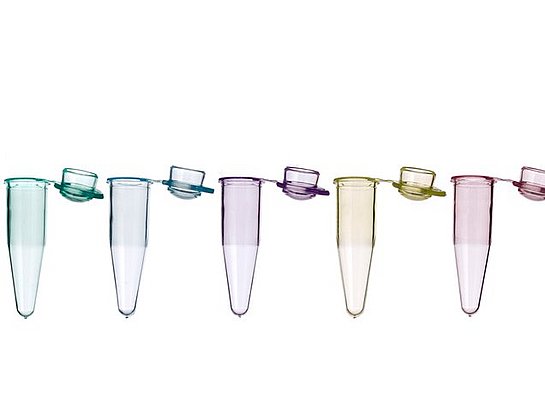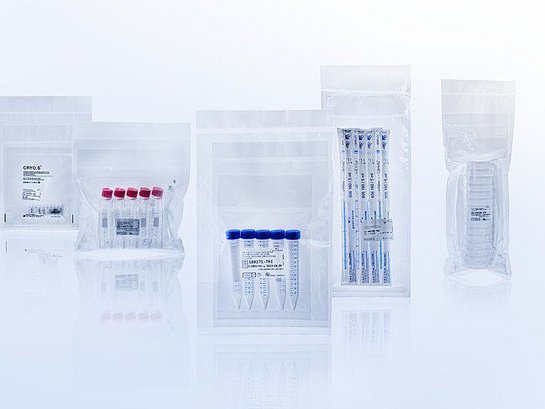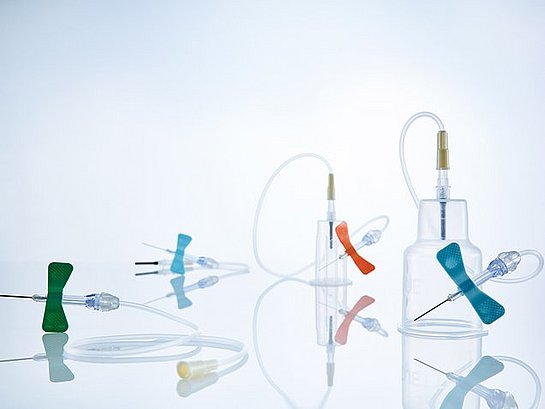Plastics in medicine and lifescience
Last edited: | Sustainability - Back to overview
Greiner Bio-One develops medical products made of plastic for clinical diagnostics, the pharmaceutical and diagnostic industry and biotechnology. Did you know that only 2-3 % of the world's production of plastics is in the field of medicine and medical technology, but over 50 % of medical-pharmaceutical products are made of plastic? This makes it one of the most widely used materials in medicine, medical technology and research, and there are many reasons for this.
Plastic – The material of choice in medical technology
Plastic makes both possible – depending on your needs. We can also use this advantage of plastic for our products.
The safety blood collection sets and IV catheters with automatic safety features, for example, have transparent viewing windows for easy recognition of successful venipuncture and flashback.
In our blood collection tubes, the transparency of the plastic allows easy recognition of the fill level. The sample quality can also be assessed at first glance.
Plastic can also be easily dyed in contrast to other materials. Opaque or coloured plastic protects especially light-sensitive additives, parameters or even drugs. This is used, for example, in our amber-coloured carrier tube for MiniCollect®. But it also makes working with our products easier: in many cases, the colour of the lid already indicates the surface quality or product variant.
Before syringes, cannulas, petri dishes or tubes could be reused in the past, they had to be extensively cleaned and sterilized. This procedure involved numerous dangers for users, patients and the analysis results.
Today you can be sure of safety: Medical devices and laboratory packaging materials made of plastic, which are used sterilely, are already packaged as such. Products that come into contact with contaminated sample material are only used once for safety reasons. This not only ensures safety for users and patients, but also makes work easier for health, nursing and laboratory staff.
Especially when you think of taking samples from patients (e.g.: with VACUETTE® Blood Collection Tubes) or working with hazardous substances in the laboratory, the stability and break resistance of plastic compared to other materials is of enormous importance. If the container is accidentally dropped, it will not break and contaminate the environment. There are no sharp-edged and contaminated splinters that could injure or infect people.
Even in the centrifuge, plastic tubes, for example, are resistant and cannot break. If the plastic tubes have to be transported by plane, car or train, this is also no problem thanks to the material. They can withstand 95kPa and drop tests and thus, as primary tubes for sample shipment, comply with the international specifications of the WHO, DGR, IATA or UN3373.
One of the most important features of plastic is its extremely low weight. This property therefore not only facilitates work with plastic products in laboratories and medicine, but also has a significant influence on the environmental balance of these products. Due to their light weight, they reduce transport costs on the one hand and can be offered at a fair price-performance ratio on the other.
In recent years biobanks have become one of the most important resources for biomedical research and development. Biobanks are used for the collection and long-term preservation of a variety of human samples in large quantities. Certain samples from the biobank are gathered together and used in investigating the causes, mechanisms and influencing factors of diseases as a function of the object of the research. Biobanks support the development of new personalised therapies and diagnostic procedures. In the field of biobankings we manufacture special Cryo.s™ biobank tubes from ultrapure USP-class VI-certified medical grade polypropylene, which is free from detachable substances (known also as leachables). The tubes allow the storage of biological samples at as low as -196°C – a temperature at which changes to the composition can be all but ruled out. We can therefore guarantee that precious samples can be stored and preserved without risk of contamination.
Even the combination of different plastics to create special surfaces or gas-impermeable products is possible. Thus, our products can meet almost every requirement of medicine and research by using plastics.
Combining different plastics - we can use this advantage in particular for our coagulation tubes On the inside, we use the extremely smooth surface and the liquid impermeability of PP. On the outside, PET makes the tube impermeable to gas. Blood sedimentation tubes made of PP are also impermeable to gas. They are simply coated on the outside with a special material.
Apart from the numerous consistent mechanical properties, which are of major importance in many research applications, high optical clarity is an essential property of plastic items, particularly in day-to-day laboratory work.
So, for example, our SCREENSTAR microplates are made from 100% cycloolefin, which is an amorphous polymer with extraordinary optical properties. These microplates reduce optical distortions and have a recessed cycloolefin film bottom, allowing the formation of peripheral wells. They have been developed for new applications in high-content-screening and in high-resolution microscopy, and in drug development and research.
As a manufacturer of medical devices and laboratory consumables, we work with state-of-the-art production facilities, that enable us to manufacture plastic products with precision. Plastic as a material is reliable and versatile, can be formed in many different ways and can thus be adapted to the most diverse conditions and needs. In this way, we are able to manufacture very fine and small-sized products that are later used in areas with high sample throughputs.
By adding various materials, plastic becomes either soft and elastic, as for example in the tubes of our VACUETTE® Safety Products, or hard and shock-resistant, as for example in blood collection tubes or tube holders. Through special coatings, the surface of plastic can even be adapted so that it can be used in the most diverse medical and research areas.
The primary objective in the disposal of medical and laboratory waste is always to ensure the safety of the user and the environment. The focus here is on preventing the transmission of diseases and environmental pollution. For this reason, there are special disposal requirements for each form of waste generated in the medical and life science sector, which counteracts illegal disposal. The legal requirements regarding the methods of disposal often differ from country to country. In principle, however, plastic (for example packaging material) is very suitable for recycling. If it is disposed of and recycled correctly, plastic can even be sustainable.
Greiner Bio-One disposal containers, for example, have a large opening for the disposal of sharp and pointed objects. The sizes offered range from a filling capacity of 0.6 litres up to 50 litres. Basically, plastic is very well suited for recycling.
Contaminated medical devices are disposed of professionally in suitable incinerators. For example, tubes are broken down into their natural components: carbon, hydrogen and oxygen. Thermal recycling allows the energy obtained from these components to be put to good use.
Inside the Lab
“Have you ever wondered what really makes laboratory products so special and why they cannot simply be made from recycled plastic or other materials?”
The answer lies in the particular requirements and properties that we demand of our laboratory consumables. When carrying out scientific experiments, total accuracy and reliability of the results are paramount. The most important prerequisite for reliable laboratory products is the purity of the raw materials used in their manufacture: The more impurities that a plastic material contains, the more these will be able to leach from the polymer into the research sample.
Leachables is a term used for compounds which under normal environmental conditions during the shelf life of a product will be dissolved out of packaging materials, coatings or closure mechanisms.
In the process, these impurities can have a number of undesirable effects on analytical results. They may have toxic effects on cell cultures, leading to disruption of cell growth or differentiation or even to cell death.
So it is not just the avoidance of impurities, but also optical clarity and consistent mechanical properties that count among the most important requirements that laboratory consumables must satisfy and which are vital for many research applications. These properties frequently cannot be guaranteed to the necessary extent if recycled materials are used. Such items are more susceptible to
- false-positive or negative results
- errors in forensic investigations
- incorrect medical diagnoses
and therefore do not deliver the constant and reliable results needed in research.
It is for this reason that as a manufacturer of plastic laboratory consumables we select production materials with minimal additives. This allows us to guarantee the high degree of reliability and reproducibility that are essential in research applications.









